Spiny McSpleen's Nifty

WEBPAGE
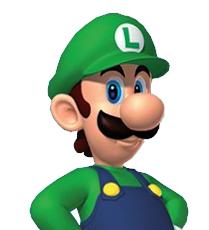
LUIGI
DEBUT: Mario Bros. (1983)
OCCUPATION: Plumber (at last check)
VOICE ACTOR: Charles Martinet
JAPANESE SPELLING:  (Ruiiji; from
(Ruiiji; from  , ruiji, meaning "Similar")
, ruiji, meaning "Similar")
NAVIGATION
History
About Luigi
Luigi & Mario
Luigi & Princess Daisy
Luigi & Waluigi
Baby Luigi
Live Action & Voice Actors
The Mind's Rubbish Bin
Related Links

In 1982, following the success of Donkey Kong in the US and Japan, Nintendo tasked game designer, Shigeru Miyamoto, with creating a new arcade game which could match its popularity. The answer came in the form of Mario Bros., a two-player game starring the hero of Donkey Kong, the carpenter-turned-plumber who had recently been named "Mario". The first player would control Mario. The second player would control what, for all intents and purposes, was a green Mario. This character, tentatively called Ruiji (Japanese for "Similar"), was a simple RYB pallette-swap of Mario, since designing a totally new sprite would mean paying someone to design it, then finding room in the system memory to store it. When the game reached the US, the text translators noted a similarity in pronunciation between "Ruiji" and the Italian proper name, Luigi. They suggested that, since Mario already had an Italian name, why should he not have a brother named "Luigi"? Miyamoto liked this idea and the name stuck.
For the next five years, Luigi and Mario were almost interchangeable, appearing in Super Mario Bros. and the NES port of the Mario Bros. arcade game as another pallette-swap of Mario. In 1988, Super Mario Bros. 2 re-introduced Luigi as his own unique character. He became taller and slimmer than his brother and he styled his moustache differently. He also gained the ability to jump higher than Mario and descending more slowly by kicking his feet in midair. He has appeared in almost as many games as his brother, but has only played the hero twice (in the non-canon Mario is Missing! and in the GameCube launch title, Luigi's Mansion).
PAGE TOP

Luigi is described in canon as being Mario's younger brother. Despite his age, he is almost a foot taller than Mario. He usually speaks in a small voice, somewhat softer but lower in pitch compared to his brother. He has a great affinity for the colour green, though he does wear red and white-striped socks. Apart from colour-scheme, his and Mario's outfits are otherwise identical. On his hat, he has a patch with the letter "L" (presumably for "Luigi", though several characters have made guesses to the contrary).
Luigi suffers from severe phantomophobia (the fear of ghosts), as displayed in Luigi's Mansion. Whilst this has made him exhibit tendencies that could be described as "cowardly", to say that Luigi is a general coward would be untrue. He seems to have no problems adventuring alongside Mario or on his own, not even being intimidated by Bowser. His only fear seems to be of ghosts. Boos will evoke the greatest reaction from Luigi. He may also have issues with being locked up, as seen in Super Mario 64 DS, when the message on his door states that screaming can be heard on the other side. However, this may be the result of Bowser having posted a Boo to stand guard inside the room.
PAGE TOP

As stated before, Mario is Luigi’s elder brother. With his constantly being the “Player 2” character, Luigi appears to be harbouring some resentment against Mario, jealous that Mario receives all the attention. He puts this jealousy to use in (the, albeit, non-canon) Super Smash Bros. Brawl, unleashing the Negative Zone when in possession of a Smash Ball. The Negative Zone is described as the manifestation of Luigi’s resentment of being in his brother’s shadow for so many years. Regardless, he does have a certain respect for Mario, stating that he wishes he could be more like him. He also enjoys adventuring with Mario and wishes would that happen more frequently. Twice, Luigi has had to rescue Mario. In Mario is Missing!, Mario was kidnapped by Bowser in a different manner depending on the platform on which the game was played (falling through a trapdoor on the Super NES, caught in a bag on the NES, caught in a net on MSDOS). In Luigi’s Mansion, Mario was captured by King Boo when he arrived at the mansion ahead of Luigi. Thus far, Mario has only needed to return the favour once (although the entire game was not dedicated to Mario rescuing Luigi) – a mission in Super Mario Galaxy to the Ghostly Galaxy had Mario rescuing Luigi from a Ghost House (a direct reversal of Luigi’s Mansion).
PAGE TOP

Princess Daisy is the princess of Sarasaland, first introduced in Super Mario Land. Despite having been saved by Mario in the aforementioned game, she has become a great friend of Luigi. There is great deal of speculation regarding the relationship between Luigi and Daisy. Evidence provided in Mario Kart Wii would suggest that they have known each other for much of their lives. Their first recorded interaction, however, was in NES Open Tournament Golf, where Daisy served as Luigi’s caddy.
During the hiatus on Daisy’s game appearances (1991-2000), the community continued to speculate on a potential relationship between the two characters. The first depiction of Luigi and Daisy together without Mario and Peach (or, “Princess Toadstool”, as she was known at that time) was in a fan-art submission to Nintendo Power magazine in 1994. Once Daisy began appearing in games again (at the request of Shigeru Miyamoto in honour of Gunpei Yokoi, his mentor and Daisy’s creator), several clues were provided as to their relationship within the games, themselves. For instance, in Mario Tennis, Daisy is Luigi’s default partner in a doubles match, and in Mario Party 5, when Luigi and Daisy are paired, the team’s name is “Steady Sweeties”. Several instruction booklets for Mario sport and party titles state that he has a crush on her, however these games are not part of the official series canon, as they have no applicable storylines. The 1993 film, Super Mario Bros. plays on the idea of Luigi and Daisy having a relationship, as the characters of Luigi Mario and Princess Daisy are infatuated with each other.
Speculation aside, however, it has been shown that Luigi and Daisy are, at least, very good friends.
PAGE TOP

Waluigi was introduced in Mario Tennis as Luigi’s self-styled archrival. It is uncertain precisely where he came from, but he and Wario appear to be partners in crime (non-canon sources have suggested that Wario and Waluigi are cousins). For some reason, he seems to absolutely despise Luigi (perhaps for the same reason why Wario despises Mario, some unseen, unexplained event). Typically, when Waluigi works with Wario to undermine the plans of the Mario Brothers, Waluigi will focus on Luigi.
Whilst Waluigi’s name appears to be merely a synthesis of “Wario” and “Luigi”, its literal meaning in Japanese (spelt Waruiji) is “Bad Luigi”. It comes from a portmanteau of warui (Japanese, “bad”) and Ruiji (Japanisation of “Luigi”).
PAGE TOP

Baby Luigi is Luigi’s younger self. First appearing in Super Mario World 2: Yoshi’s Island, Baby Luigi served the “damsel in distress” role typically played by Princess Peach. Like Baby Mario, Mario & Luigi: Partners In Time established that Baby Luigi is, indeed, a younger Luigi, when the adult Mario Brothers travel back in time to meet themselves in the past. Baby Luigi has appeared in several Mario Kart titles alongside Baby Mario and their adult counterparts.
PAGE TOP

These people have played Luigi in voice, in person, or both.
VOICES
Charles Martinet (current)
Yu Mizushima (Super Mario Bros. Peach-hime Kyushutsu Dai Sakusen! [anime], Mario Kart 64 [Japan], Mario Party, Mario Kart: Super Circuit)
Naoki Tatsuta (Super Mario [anime])
Marc Graue (Hotel Mario)
Danny Wells (The Super Mario Bros. Super Show!)
Tony Rosato (The Adventures of Super Mario Bros. 3, Super Mario World [animated series])
ACTORS
Danny Wells (The Super Mario Bros. Super Show!)
John Leguizamo (Super Mario Bros. [film])
PAGE TOP

In the instructional literature for Super Mario Bros. 2, Luigi is described as the more intelligent of the Mario Brothers. The Super Mario Bros. Super Show! and Adventures of Super Mario Bros. 3 typically portrayed Luigi as less intelligent. Currently, it is believed that both Mario Brothers have equal intelligence, but Luigi is less logical and more prone to spur-of-the-moment actions (if there's a button on the wall, press it, because you can).
Luigi is the more emotional of the Mario Brothers. In Mario & Luigi: Partners in Time, he begins to cry after being reunited with the Baby Mario Brothers. Also, he is more easily startled and he exhibits outright fear around ghosts.
Luigi's Mansion is the first canon source to portray Luigi as cowardly - now a permanent character trait.
It may be that Luigi is thunder-adept or skilled in manipulating electricity, whilst fire is Mario's element. Luigi has displayed proficiency in manipulating fire, as well, demonstrating this skill in most Mario side-scrollers and in the Super Smash Bros. series.
Luigi's moustache is a very dark brown colour, rather than black.
Luigi has more spoken (or written) dialogue in the series than Mario.
In Super Smash Bros. Melee and Brawl, whilst Mario makes a proper fist, Luigi holds his thumbs. He also appears to have mastered the "windmill punch", a manoeuvre dismissed by professional wrestlers as too clumsy and inefficient.
Super Smash Bros. Brawl was the first game in the Smash series where Charles Martinet performed the voices of Mario and Luigi separately. In previous titles, Luigi's voice was simply Mario's voice, sped up.
Luigi did not appear in any new games during the year 1994. He also did not appear in any platformers for the original Game Boy or the Nintendo 64.
The first game where Luigi's name appears in the title is Luigi's Mansion. Since then, his name has appeared in the titles of the three Mario & Luigi series games. However, Luigi's Mansion remains the only game where his name appears independently of Mario's.
In each new release of Super Mario World (except the Wii Virtual Console version, which uses the original Mario World ROM), Luigi's appearance and abilities change. In the original version, he was a simple pallette-swap of Mario. In Super Mario All-Stars + Super Mario World, his sprite was redesigned, making him appear taller and thinner than Mario; he would spit fireballs, rather than throw them; and he would slide down hills on his knees. In Super Mario Advance 2: Super Mario World, he was redesigned again, he was lighter and could fly higher than Mario, and Yoshi would behave differently with Luigi than with Mario.
Super Mario 64 was the first Mario platformer not to feature Luigi (until that point, every platformer in the series was a two-player game, featuring Luigi as player 2). It was not until the Wii title, Super Mario Galaxy, eleven years later that both Mario Brothers appeared and were playable (though independently) in a Mario platformer.
PAGE TOP


Luigi's game sprites, several of which are Mario pallette-swaps. From left to right: Mario Bros., Super Mario Bros., Super Mario Bros. 2, Super Mario Bros. 3, Super Mario World, Super Mario All-Stars (SMB1, 2, 3, Super Mario World), Super Mario Bros. Deluxe, Super Mario Advance 2: Super Mario World, Mario & Luigi: Superstar Saga
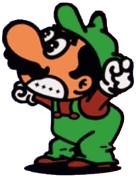
Luigi in Mario Bros.
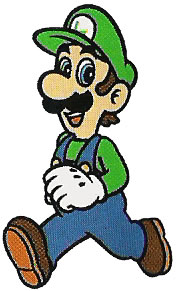
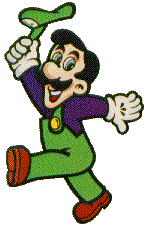
Official artwork from Super Mario Bros. 2 and Super Mario Bros. 3
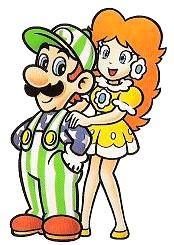
Luigi and Daisy in NES Open Tournament Golf
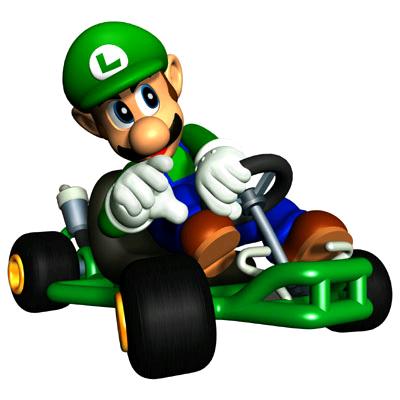
Promotional art for Mario Kart: Super Circuit
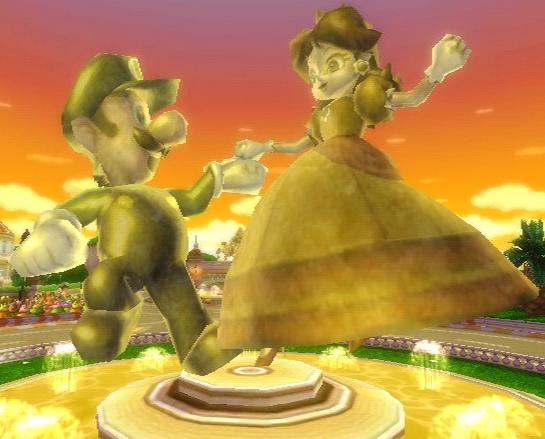
A statue of Luigi and Daisy on Mario Kart Wii's track, Daisy Circuit
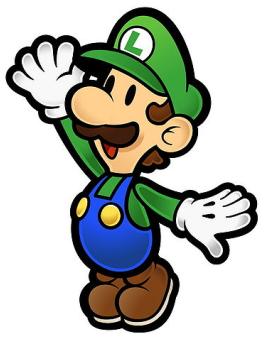
Paper Luigi
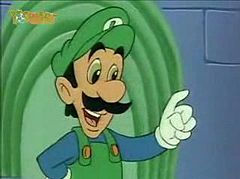
Luigi in the animated television series based on Super Mario World

Spiny McSpleen's Nifty Charles Martinet Page
Luigi on Wikipedia
Luigi on Wikia: Super Mario
Luigi on the Smash Bros. DOJO!
The official Nintendo Website
PAGE TOP
HOME
Luigi, Super Mario Bros., and all related indicia are the property of Nintendo. © 1983-2008 Nintendo.
Page coding and layout by J. Sebastian Perry (a.k.a. Spiny McSpleen).




 (Ruiiji; from
(Ruiiji; from  , ruiji, meaning "Similar")
, ruiji, meaning "Similar")


















